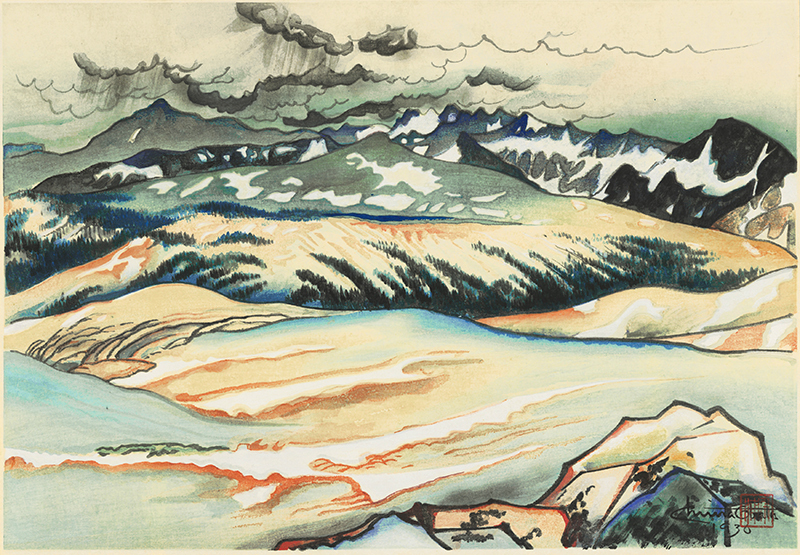
19th, 20th & 21st Century Fine Prints
707-546-7352 · fax 707-546-7924 · web: www.annexgalleries.com · email: artannex@aol.com
Great Nature, Storm on Mount Lyell from Johnson Peak by Chiura Obata

Great Nature, Storm on Mount Lyell from Johnson Peak
Chiura Obata
Great Nature, Storm on Mount Lyell from Johnson Peak
Chiura Obata
1885 - 1975 (biography)An exceptional impression of "Great Nature, Storm on Mount Lyall from Johnson Pass" which was number 8 in Obata's "America" section of his projected "World Landscape Series" and required 125 sequential impressions. The printing was done in Japan by the artist working with the Takamazawa Color-Print Studio. The whole project required over 32 carvers and 40 printers over a period of two and one-half years to finish and as many as 205 blocks for each image. The Japanese editions were apparently only stamped with the artist's seal for the Japanese audience, not signed with an English signature, the American editions were signed with sumi ink. This impression has the artist's seal and signature in the lower right corner, other impressions were stamped and signed in the lower left. The coloring of this image varies substantially.
Though supposedly done in a total edition of 100 they are exceedingly rare, half the edition stayed in Japan and the rest came to the united States where many were destroyed during WWII when having "Japanese" art was considered by many to be unpatriotic.
Chiura Obata was born in 1885 in Okayama prefecture, Japan. At the age of 14, he went to Tokyo where he studied with Tanryo Murata, Kogyo Terasaki, and Goho Hashimoto. In 1903 he moved to San Francisco. While working as an illustrator for the city's Japanese newspapers "The New World" and the "Japanese American", Obata made on-site sketches of the San Francisco earthquake. He married Haruki Kohashi in 1912, and from 1915 to 1927 worked as an illustrator for Japan Magazine. He spent much of the 1920s painting landscapes throughout California and helped establish the Eastwest Art Society in San Francisco in 1921.
He spent the summer of 1927 on a sketching tour of Yosemite and the Sierra high country producing over 100 new paintings. In 1928 Obata returned to Japan, following his father's death. While there, he supervised the production of 35 colored woodblock prints of California landscapes for his World Landscape Series. They were exhibited at the "Eighty-Seventh Annual Exhibition" at Ueno Park, Tokyo; "Lake Basin in the High Sierra" won first prize.
In 1932 Obata was appointed as an instructor in the Art Department at the University of California, Berkeley. Between 1930 and 1941, one-man exhibitions were held in numerous locations. In April 1942, Obata was interned at the Tanforan detention center where, during his stay, he organized an art school with over 650 camp residents as students. In September 1942, he was moved to the Topaz Relocation Center, Topaz, Utah. Released from Topaz in 1943, he moved with his family to St. Louis, finding employment with a commercial art company.
In 1945, when the military exclusion ban was lifted, Obata was reinstated as an instructor at U.C. Berkeley. He was promoted to Associate Professor of Art in 1948. One-Man shows continued, as did his sketching and painting trips in the high country, often with the Sierra Club. In 1954 he became a naturalized citizen and retired as Professor Emeritus from U.C. Berkeley. From 1955 to 1970 he traveled throughout California giving lectures and demonstrations on Japanese brush painting. In 1965 he received the Order of the Sacred Treasure, 5th Class, Emperor's Award, for promoting goodwill and cultural understanding between the United States and Japan. He died in 1975, aged 90.
